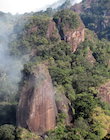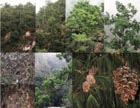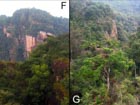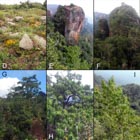Pinus cernua
L. K. Phan ex Aver., K. S. Nguyen & T. H. Nguyen 2014
Common names
Taxonomic notes
Type: From the border of northern Laos and Vietnam (“Son La and Houaphan provinces border”), 2013.11.12, L. Averyanov et al. CPC 6992; the initial discovery was in late 2011 by Vietnamese geologists working in the area (Averyanov et al. 2017). Syn. P. armandii auct. non Franch. (Phan et al. 2013), P. fenzeliana auct. non Hand.-Mazz. (Businský 2004), P. armandii Franchet subsp. xuannhaensis L.K. Phan (Phan Ke Loc et al. 2014a, b). In describing this new white pine, Averyanov et al. (2014) state "this new species probably has some relation to the variable complex of P. fenzeliana Hand.-Mazz. and P. armandii Franch." but it seems a clearer understanding must await molecular study. Meanwhile, species status seems to be widely accepted, perhaps partly due to the exceptionally complete study and documentation of this new taxon as provided by Averyanov et al. (2017).
For more discussion of systematics relative to other species in subsection Strobus, see Phylogeny of East Asian white pines.
Description
Tree to 35 m tall and 1000 cm dbh, with a conical crown of suberect to pendulous branches that in older trees becomes irregularly rounded. Bark on mature trees dull gray-brown to dark brown, roughly fissured into irregular polygonal flat or slightly concave plates, often resinous; inner bark red–brown, finely fibrous. Twigs gray–green, olive or yellow–brown, slightly glaucous, glabrous. Winter buds orange–brown, cylindric, 10-20 × 3–5 mm; scales narrowly triangular, (3)4–5 mm long, acuminate, with slightly recurved scarious apex. Needles in fascicles of 5, the sheath early deciduous, (12-)15–20(-22) cm long, 0.8–1.2 mm thick, bright dark green, slender, drooping, slightly twisted, triangular in cross section; vascular bundle 1, resin ducts 3, medial and two marginal. Pollen cones numerous in spiral clusters at the base of new shoots, ovoid, later elongate, suberect, more or less stout, 8-15 × 6–8 mm. Seed cones on stout peduncles 1–2 cm long, alone or commonly in whorls of 2–6, erect, later erect to pendulous, persisting for many years, brown to dark brown, ovoid, 8–11 × 5–7 cm, dehiscent at maturity, often resinous. Seed scales woody, rigid, obovate-deltoid, 2.4–2.8(-3.0) cm long, 1.5–2.5 cm wide, apophysis deltoid, recurved and thickened at apex; umbo insignificant, without mucro. Seeds dark brown, smooth, obliquely obovoid, 10–12 mm long, with a rudimentary scarious thin wing 1–2 mm wide disintegrating by seed maturity and occasionally leaving a low irregular distal ridge. Pollination February–March, seeds September–October (Fig. 11–12) (Averyanov et al. 2014).
Distribution and Ecology
Laos: Houaphan; Vietnam: Son La; only on small, isolated, highly eroded remnant peaks dissected by deep canyons, where it has been found at 23 locations, all in the Pha Luong Mountains (20.68°N, 104.65°E) on the Laos-Vietnam border; see Averyanov et al. (2017) for a detailed map. The eastern part of Pha Luong Mountains is included presently into Xuan Nha nature reserve (Vietnam); Laotian lands are unprotected, and inspection of the satellite image shows extensive intact native forest in the Vietnamese portion of the mountains, but extensive development and wildfire evidence in the Laotian portion. The climate is monsoonal, tropical, with mean monthly temperatures of of 11.8-23.1°C and mainly May-October rainfall with an annual total of about 1560 mm; frequent fogs and mists throughout the year ensure that moisture stress is rare and support diverse epiphytes. The pine is found in evergreen mixed tropical submontane forest and evergreen coniferous tropical submontane forest, occurring on steep slopes, cliffs and rocky outcrops of remnant, highly eroded solid sandstone at elevations of 900-1500 m. Occasional conifer associates are Amentotaxus argotaenia, A. yunnanensis, Cephalotaxus mannii, Chamaecyparis hodginsii, Dacrycarpus imbricatus, Keteleeria evelyniana, Pinus latteri, and Podocarpus neriifolius (Averyanov et al. 2014, 2017). Saplings have been observed on open rocky slopes and cliff shelves, but in shady forest on mountain summits regeneration is very poor or absent (Phan et al. 2013). Averyanov et al. (2014) further explain that "Deep erosion of the solid orange–brown sandstones forms unique picturesque landforms with numerous rocky ridge edges, very steep cliff slopes and rocky outcrops on the tops of remnant mesas. P. cernua inhabits almost exclusively steep rocky slopes and cliffs. This may be caused by its zoochores (most probably birds or rodents) delivering seeds into such inaccessible habitats where they can germinate and develop."
This species occurs on cliff sites that are small in size and are severely fragmented with a total area of occupancy of less than 3 km2, within an extent of occurrence that declined from about 20 km2 to 15 km2 in the first 5 years after the species was detected; in the process, extinction of one occurrence was recorded. Pinus cernua is thus Critically Endangered under IUCN red list criteria. Principal threats include occasional wildfire, logging, deforestation and habitat loss. They further suggest that protection and monitoring, ex-situ propagation, and introduction into cultivation as an ornamental tree may be effective to support species conservation (Averyanov et al. 2014, 2017).
Remarkable Specimens
Averyanov et al. (2017) found annual rings 0.5–1 mm wide in plants found on relatively dry open rocky summits, speculating ages of up to 200 years.
Ethnobotany
Observations
Remarks
The epithet "cernua" is Latin for "drooping forwards" or "with bowed head;" here it refers to the long slender weeping needles and drooping branches of old trees growing on open rocky cliffs (Averyanov et al. 2014).
The seed cones in most subpopulations develop a high percentage of mutilated abnormal or abortive seeds, or no seed at all (Averyanov et al. 2017); this may be a factor contributing to the endemism of this species, and the very infrequent observed regeneration. Germination and ex situ cultivation show 50-60% germination success, with good growth and development (Averyanov et al. 2017).
Citations
Averyanov, L. V., T. H. Nguyen, K. N. Sinh, T. V. Pham, V. Lamxay, S. Bounphanmy, S. Lorphengsy, L. K. Phan, S. Lanorsavanh, and K. Chantthavongsa. 2014. Gymnosperms of Laos. Nordic Journal of Botany 32(6):765–805.
Averyanov, L. V., K. S. Nguyễn, T. H. Nguyễn, T. S. Nguyễn, and T. V. Maisak. 2017. Conservation assessment of Pinus cernua (Pinaceae). Turczaninowia 20(4):159–184.
Businský, R. 2004. A revision of the Asian Pinus subsection Strobus. Willdenowia 34 (1): 39-57.
Phan, Ke Loc, V. T. Pham, S. K. Nguyen, T. T. H. Nguyen, and L. V. Averyanov. 2013. Native conifers of Vietnam. Updated checklist 2013. Ecol. Econ. J 45:33-50.
Phan Ke Loc, Phan Van Thang, Ha Cong Liem, and Nguyen Duc To Luu. 2014a. Pinus armandii subsp. xuannhaensis (Pinaceae), a new subspecies of pine from Vietnam. Natural Sciences Technology (Hanoi) 30, 3S: 53–60.
Phan Ke Loc, Phan Van Trang, Ha Cong Liem, and Nguyen Duc To Luu. 2014b. Updated knowledge to Xuan nha pine Pinus armandii Franch, subsp. xuannhaensis L. K. Phan in Vietnam. Journal Ecology Economy (Hanoi) 46: 66–75.
See also





